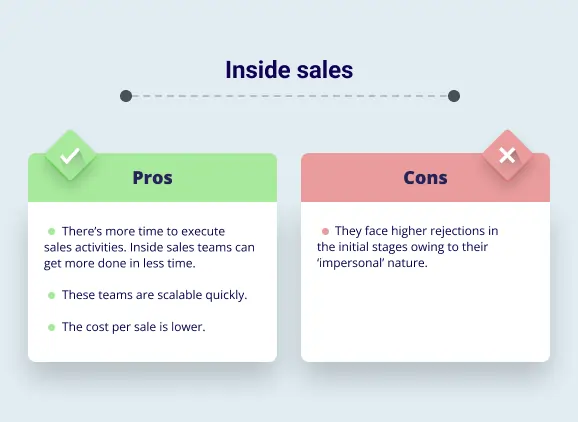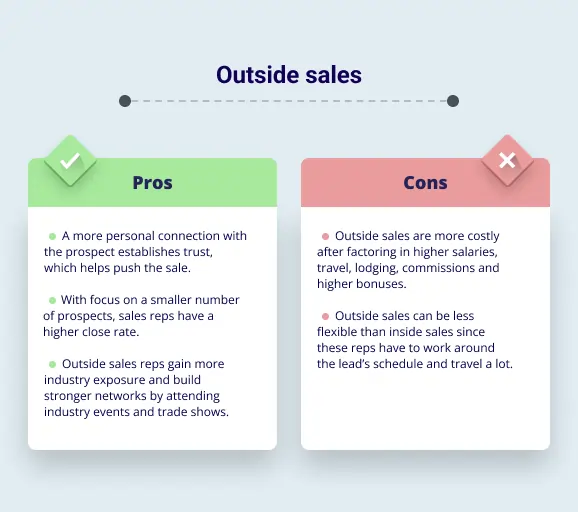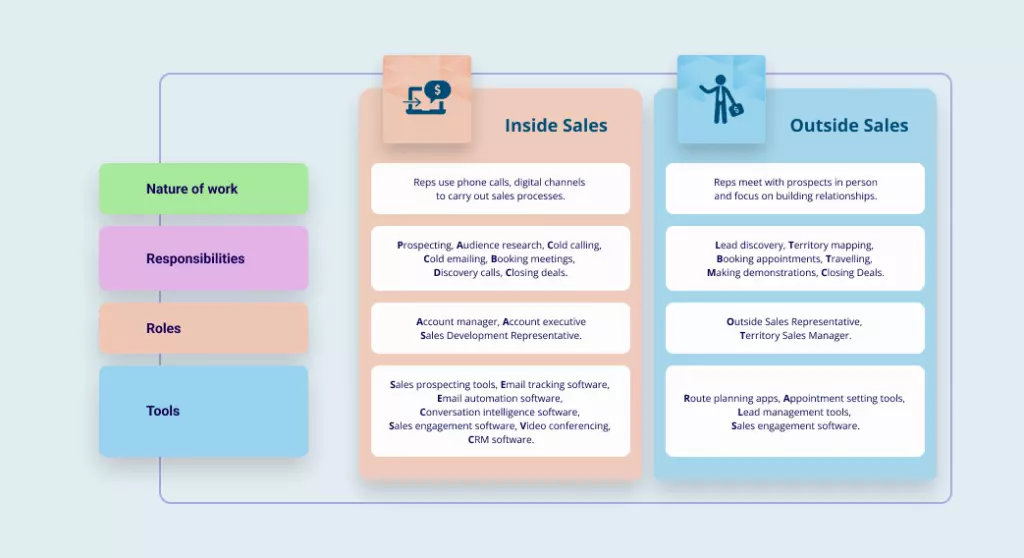“Who can sell **** drug better than me?”
Only an outrageously confident sales rep could have asked to go door to door to sell something as tabooed as a sexual performance enhancement drug. But the devilishly handsome Jake Gyllenhaal does it - might we add, successfully - in Love and Other Drugs.
That’s the outside sales rep for you - confident, outgoing, persuasive, socially adept, and often, irresistible. In fact, they’ve spawned a whole body of cinema in Hollywood. (Read: Will Smith in Pursuit of Happyness and Leonardo DiCaprio in The Wolf of Wall Street)
Now, with the work-from-home model, remote selling became the norm - and thrived. In 2020, 64% sales leaders exceeded or met their goals after switching to remote work and 63% said virtual meetings were as effective as in-person meetings.
Earlier, it was understood that inside sales - through phone calls, emails, CRM and other tech-enabled tools - would be used for smaller products. The legwork-heavy outside sales method was reserved for larger products.
But companies have now had a chance to examine the performance of inside sales where outside sales was traditionally used. Is it really possible to execute sales operations with desk-bound teams?
That couldn’t be further from the truth. Outside sales continue to be a reality for most organisations. Conferences, speaking engagements and other offsite events are still watering holes for sales reps and prospects.
Interestingly, the two methods are also becoming symbiotic. On-field reps are acquiring digital skills and inside sales are increasingly using conversational tools replicating outside sales.
In this blog, we revisit the ABCs of both methods to help you incorporate the best of both in your sales strategy.
What Is Inside Sales?
Inside sales is a desk job. It requires sales reps to make phone calls, use video conferencing, emails and other digital channels to connect with leads. The term was first used in the 1980s for telemarketing. By the 2000s, the jargon shifted to refer to in-office sales.
What Does an Inside Salesperson Do?
The day-to-day responsibilities of an inside sales rep include researching, prospecting, making cold calls, personalising and sending cold emails, handling objections, and managing the sales pipeline.
- Prospecting: This is the first step in sales - identifying potential customers.
- Audience research: Sales reps must learn more about their leads, their product offering, and the markets in which they operate. These insights allow reps to come up with talking points during their presentation.
- Cold calling/emailing: Inside reps solicit prospects who haven’t had any prior interaction with the company. Methods of reaching out to these potential customers include emails and phone calling.
- Follow up with prospects: Reps nurture intent in prospects by following up with them on LinkedIn, or with personalised emails. Salespeople are always handling objections or negotiating with prospects, while crossing off a number of action items on their to-do list.
- Discovery calls: Salespeople could conduct up to 3 or 4 discovery calls a day depending on their team’s bandwidth.
- Handling objections: Facing objections can be an awkward part of sales conversations. Training for handling objections involves teaching how to listen, understand, respond and confirm patiently and firmly.
- Closing deals: The bottomline of all sales endeavours is to close deals. Common closing techniques to teach include assumptive close, puppy dog close, scale close, scarcity close, takeaway close and summary close.
How Do You Set up an Inside Sales Team?
Chances are that you already have an inside sales team - or some framework resembling it - in place. Here’s how to set up an inside sales team from scratch, but it’s worth trying even if you’re looking to better organise your existing workforce –
Define Roles:
- Sales development representative:
- If they work for outbound, s/he carries out prospecting
- Ensures that leads are qualified
- Ensures leads are flowing into the pipeline regularly
- Promotes services and products
- Communicates with all organisational levels
- In charge of closing open deals
- Handles all objections in a deal
- Negotiates with prospects on price
- Point of contact for clients
- Handles customer complaints
- Monitors and reviews sales pipeline
- Account manager:
- Responsible for managing customer relationships
- Maintains good relationships with customers
- Finds fresh sales opportunities
- Makes account and transaction reports
- Sales manager:
- Forecasts revenue and drives salespeople to hit them
- Adopts new sales strategies to open new markets or achieve new targets
- Oversees lead generation
- Oversees the sales team and conducts regular meetings to monitor their progress towards meeting their goals.
- Hires, trains, motivates and guides sales reps
- Reviews pipeline on the daily
- Tracks sales people’s KPIs regularly
- Create reports on sales teams’ and individual sales people’s performances.
Inside Sales Teams Goals and Metrics
Inside sales teams are driven by key performance indicators (KPIs). Establishing these right from the get-go can help give your reps direction. Here are some of the metrics to lay down for various inside sales roles -
SDR: An SDR’s goal would be to book X number of meetings with prospects a month, a week or quarterly. Their performance can be measured by closely following these metrics:
- Number of calls made per day or week
- Number of social touches made per day or week
- Number of emails per day or week
- Marketing qualified leads to sales qualified leads conversion rate
- Sales qualified leads to opportunities conversion rate
Account Executive: The main goal of account executives is to close deals. Here are some KPIs you can check to track an AE’s performance:
- Number of calls made per opportunity
- Number of touches to closure
- Pipeline coverage ratio
- Sales velocity
- Opportunity win rate
Account manager: An account manager’s job is to maintain relationships with the clients assigned to them. Here are the metrics that matter to this persona:
- Customer lifetime value
- Customer satisfaction
- Customer acquisition rate
- Customer churn rate
- Average Resolution Time
- Average response time
- Touches to resolution
Inside Sales Tech Stack:
These are some of the tools at the disposal of an inside sales team -
- CRM software to manage prospect data, keep records of sales services and track user journeys
- Sales prospecting tools for lead generation
- Sales intelligence software to monitor the progress of sales reps and figure out best outreach strategies
- Email tracking and automation to send cold emails, automate follow-ups at scale and get email metrics
- Cold calling software to make calls quickly, train reps on how to cold call, identify best cold calling strategies
- LinkedIn automation tools to automate outreach on LinkedIn
- Sales engagement tools to automate outreach, and scale outreach process effectively
- Video conferencing tools for product demonstration
How To Train Your Inside Sales Team
- Establish a standardised cadence approach: Inside sales teams would have already established the sales process. New joiners should be trained to use standardized cadences.
- Live coaching: New recruits can be trained for cold calling through live coaching. This enables managers to drop into the conversation reps have with prospects and handhold them if needed.
- Product and market knowledge: Sales teams should be well versed with the customisations, price, ROI, features and usage of the product. They should be equipped to answer any questions, formulate value propositions and perform competitor analysis.
- Shadow best-performing colleagues: New joiners can learn and develop basic skills like prospecting, handling escalations and objections, and closing deals by shadowing their experienced colleagues.
- Foster a culture of motivation: Compensation, bonuses, promotions and staff rankings – all these are great motivators for inside sales reps. By cultivating healthy competition, you can also ensure your reps challenge one another leading to stellar performance from your overall team.
- Enable cross-team functioning: Partnering with other teams, especially marketing, can help provide educational materials for new sales reps. It gives your team a better sense of the company’s positioning and messaging which can influence their sales conversations.
- Provide sales enablement: Arm salespeople with sales enablement materials to get selling faster, or help newer reps settle into their new roles easily.
Inside Sales Pros & Cons

When Should You Get an Inside Sales Team?
Before you jump the gun and start assembling resources to set up an inside sales team, give some thought to whether you need one in the first place. Get an inside sales team -
- If your product has a smaller annual contract value
- If you want to achieve higher sales velocity
- If you want to reach out to more prospects
- If your product requires minimal decision making from customers
What Is Outside Sales?
Outside reps are tasked with on-field sales processes. They travel, meet prospects in person, and spend time building relationships. Before the sales automation and scalability of outreach processes, field sales were the norm and the travelling salesperson, a common sight.
Here’s what an outside sales rep does –
- Lead discovery: There are a number of ways to zero down on leads - from physically attending conferences, seminars, trade shows and events to using online tools like LinkedIn - to get in touch with prospects.
- Territory mapping: Sales reps mark their territory and define the best routes to save time and operate efficiently. The objective is to reduce fuel costs and travel time.
- Book appointments: Setting up appointments is a recurring exercise for outside sales reps. They use tools to keep track of these appointments and often have a script prepared to set up interviews.
- Make presentations: Create a presentation for customers addressing all pain points using various resources. They also give in-person demos to show the whole suite of features and services.
- Close: Field sales reps are quota carrying salespeople who are in charge of closing the deals.
How To Set up an Outside Sales Team
Outside sales teams may be divided by regions, which has territories. Each territory will be covered by a certain number of sales reps and a sales manager.
Define Roles -
- Sales development representative:
- Face-to-face meeting with prospects
- Covers predefined territories
- File expense reports
- Attends trade shows, visits industry events or buyers’ offices to prospect
- LinkedIn prospecting
- Keeps records of leads, accounts and sales
- Closes deals
- Territory Sales Manager:
- Leads the sales team to meet their quotas and sales goals
- Monitor field staff working on a particular territory
- Builds sales strategies to open new accounts, improve sales productivity
- Monitor team and individual performances
- Coach, and motivate team members
- Forecast revenue and drive salespeople to achieve it
- Review pipeline and set quarterly/monthly goals
Metrics and Goals
Here are the metrics that field sales reps keep track of in order to achieve their goals:
- Sales rep: The goal of outside sales reps is to cultivate relationships with the objective of closing deals. Here’re the KPIs you need to track:
- Target vs achievement
- Number of accounts engaged
- Number of active accounts
- Number of meetings per day
- Total idle time in the field
- Average talk time per call
- Close ratio
- Sales manager: The metrics to track the progress of a sales manager’s performance towards the goal can depend on a number of things - like the industry you’re in, and the way your team is structured. But here are some general KPIs you need to track.
- Lead response time
- Revenue
- Cost per lead
- Sales volume
- Cross sell and upsell rates
- Calls and emails per rep
- Conversion time
- Opportunities created
Tools for an Outside Sales Team
The power of persuasion is the most effective tool in an outside sales rep’s arsenal. But here are some other tools that help make their job easy:
- CRM softwares to manage prospect data
- Route planning apps or maps to optimise the travelling involved in the field sales process
- LinkedIn Prospecting tools
- Appointment setting tools to ensure multiple appointments can be set quickly
- Lead management platform to manage, filter, and categorise leads
- File sharing apps to share large product documents on the go
- Field sales management software that lets you track reps in the field, monitors their task execution, and takes attendance.
How To Train Your Outside Sales Team
- Perform gap analysis: As a manager, you can analyse areas where your individual reps lack in competency. You can then discuss these with the rep, explain the rationale behind your assessment and remedy the gaps with the right training.
- Qualifying prospects: Teach your reps how to qualify prospects using proven methodologies like MEDDIC, BANT and SPIN. Prepare sample questionnaires for their reference.
- Rehearse pitches: Rehearse different demo scripts with colleagues and land on the most effective approach. Teams can be encouraged to try out different selling approaches to finetune their conversations with prospects.
- Body language: Outside reps should learn to support their pitches with the appropriate body language. Reading buyers’ facial expressions and demeanour can also help reps adjust their approach and form their responses.
Outside Sales Pros & Cons

When Should You Have Outside Sales?
An outside sales team is expensive to maintain. The nature of your product and your sales cycle, among other things, can tell you whether an outside sales team is the right option for you. Here’s what to consider before investing in such a team:
- If you are selling a product with higher ACV
- If your product needs to be demonstrated in person
- If you have longer sales cycles
- If the cost of customer acquisition is high
- If your product solves a complex problem
Infographic:

To Wrap Up…
Both methods exhibit undeniable merits and can be deployed by themselves, or in a hybrid model.
Inside sales rose to the occasion when remote work was adopted universally. But as we adjust to a ‘new normal, outside sales has to be brought back to tap into the full potential of your workforce. Once you take stock of your reps’ capabilities, you can play around with the team’s structure to arrive at a model that works best for you.

